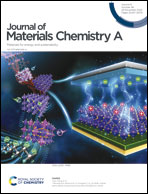The role of surface lattice defects of CeO2−δ nanoparticles as a scavenging redox catalyst in polymer electrolyte membrane fuel cells†
Abstract
The present investigation deals with the optimization of the concentration of lattice cerium(III)  and oxygen vacancy
and oxygen vacancy  concentration, over the surface of CeO2−δ nanoparticles by varying the processing parameters. The higher
concentration, over the surface of CeO2−δ nanoparticles by varying the processing parameters. The higher  value was found to be in good agreement with the smaller grain size and transformation of tetravalent lattice cerium
value was found to be in good agreement with the smaller grain size and transformation of tetravalent lattice cerium  . This transformation explains the crucial mechanism behind the excellent scavenging behavior of CeO2−δ nanoparticles, towards degradation mitigation in the polymer electrolyte membrane (PEM). The overall degradation rate was suppressed 4.2 and 2.7 times after incorporation of CeO2−δ (100 °C, 24 hours) nanoparticles annealed in the hydrogen and oxygen atmosphere, respectively. It was estimated that the intrinsic lattice strain effect on the curved surface of nanoparticles could affect their surficial reactions. The presence of a high oxygen vacancy concentration inducing higher
. This transformation explains the crucial mechanism behind the excellent scavenging behavior of CeO2−δ nanoparticles, towards degradation mitigation in the polymer electrolyte membrane (PEM). The overall degradation rate was suppressed 4.2 and 2.7 times after incorporation of CeO2−δ (100 °C, 24 hours) nanoparticles annealed in the hydrogen and oxygen atmosphere, respectively. It was estimated that the intrinsic lattice strain effect on the curved surface of nanoparticles could affect their surficial reactions. The presence of a high oxygen vacancy concentration inducing higher  generation has a crucial effect on the exceptional durability of the hybrid CeO2−δ integrated Nafion film.
generation has a crucial effect on the exceptional durability of the hybrid CeO2−δ integrated Nafion film.



 Please wait while we load your content...
Please wait while we load your content...